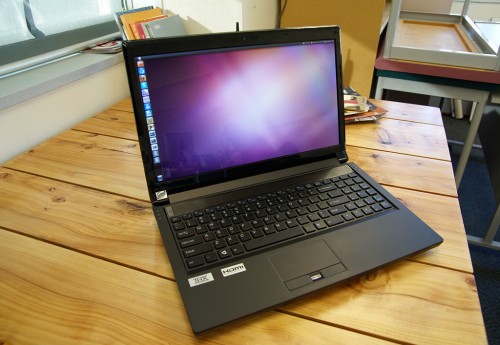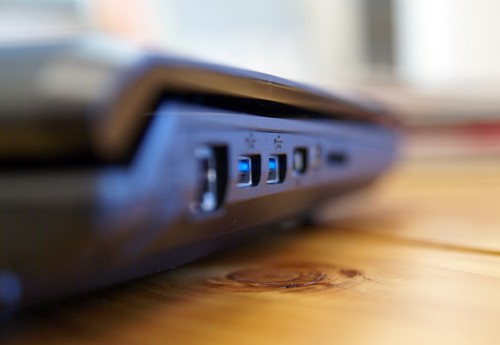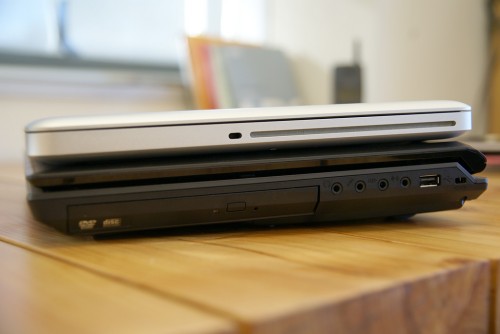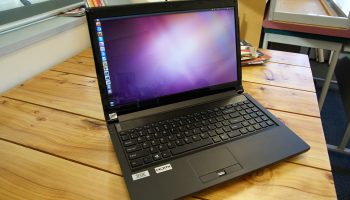Independent Ubuntu computer manufacturer System76 refreshed their popular 15.6″ Serval Professional line earlier this year, upgrading the laptop with an impressively fast second gen Intel Sandy Bridge i7 quad core processor, powerful Nvidia graphics, a lovely 1080p display and lots of options for optical drives and storage.
On the outside this model sports a refreshed chiclet-style keyboard, a larger multitouch trackpad, improved aesthetics, and a soft rubber finish.
The result is a ridiculously powerful and good looking desktop replacement from System76, and in the base configuration starting at $1,369 USD, competitively priced against other similarly spec’d computers including the latest MacBook Pro.
Hardware look and feel
After using this laptop as my main computer for a few days, I’ve come to appreciate the very simple design. It’s probably one of the most minimal non-Apple built laptops available, with a black rubber finish, little hardware buttons, and a very neutral colour pallete that never strays far from a menacing black tone.
It sports some nice edgy lines and sharp edges, although if this is the route System76 would like to take with the Serval, I think the sharp lines and angles could even be taken further to truly make this laptop stand out.
The twin fan grills at the rear give it a menacing feel. If Batman had a laptop to complement his tank in The Dark Knight, it might look something like this. Sometimes I think if I press the wrong button, missiles just might fly out of the USB ports.
If Batman had a laptop to complement his tank in The Dark Knight, it might look something like this.
Weighing in at just over three kilograms (6.8 pounds), this isn’t going to be the ideal computer for people who like to travel a lot. While it’s easy enough to carry under one arm, it’s quite bulky but feels durable, and for a laptop built in 2011, a bit thicker than similar spec’d computers.
The quality of the construction seems very good. Nothing squeaks, the screen hinge is very sturdy and the lack of a hatch switch to open and close the lid is something to be appreciated, further adding to the simple design. The plastic that the computer is constructed from doesn’t feel cheap. I get the impression that each one of these units is built with care.
The untextured, plain rubber finish that graces most of the body is unusual, but great in the fact that it doesn’t leave any fingerprints. It also doesn’t scratch. Being matte, the Serval does not feel like it’s trying to show off. When people see you rocking this bad boy, they’ll know you’re all about compiling kernels and hacking in C, not watching Glee.
Keyboard, screen, sound, and trackpad
I’ve never seen a nicer screen on a laptop. The Serval Professional comes standard with a 1920 x 1080 super glossy LCD, with an option for matte for $100 extra. The screen has an impressively wide brightness range, and there’s a nice fade when changing between brightness levels. A function option that turns the screen backlight entirely off might be useful for some people.
Everything is very sharp at 1920 x 1080 and the colour representation seemed excellent. Interestingly, at this resolution on a 15.6″ screen, the Unity launcher icons (48px by default) and the Ubuntu system font are the perfect size. I know that a big criticism of Unity has been that everything is large and childish, but certainly when working at this resolution it seems the defaults are perfect.
The keyboard is similar to the MacBook style chiclet keyboard, with flat, square keys and wide spacing between each. Thankfully, there’s nothing unusual in the layout, although the dedicated numeric keys on the very right are missing the extra column that would usually hold the page up and page down keys.
Of course there is an Ubuntu key instead of a Windows key, but I was disappointed to see that this is simply a sticker.
One thing I miss on the Serval Professional is dedicated multimedia shortcut keys – being able to pause and skip tracks in one punch of a button is something I’m used to from my Toshiba Satellite, and I think the Serval Professional has enough space above the keyboard for this feature in future iterations.
Sound quality through the internal speakers was average, although they go very loud. Strangely there’s a speaker on the underside of the laptop. Unfortunately I found a bug in my model where sound output via the 3.5mm headphone jack was very muddy and missing low and high range. I let System76 know and they’re working on a fix – whether it’s a software or hardware issue is still to be found out.
The multitouch (just two finger scroll by default) trackpad is a good size and has the same finish as the rubber on the rest of the laptop. It’s nice to use and smooth enough, and thanks to its size, comfortable to use. The buttons on the mouse make a satisfying click when pressed, and feel solid.
There’s also a fingerprint reader between the two trackpad buttons – although this doesn’t work by default and takes a lot of effort to set up in Ubuntu, which is a shame.
Performance and battery life
This thing is fast. I’ve never seen LibreOffice open up as quickly on any other laptop, thanks to the SSD, 8GB of RAM, and quad qore Intel i7 my review unit came with. Unity runs beautifully and is very snappy, and all default applications in Ubuntu are very responsive. The Serval Professional makes Ubuntu a joy to use.
Running Family Farm at 1920 x 1080 with 4x antialiasing was super smooth, and glxgears ran at 14,000 FPS - not surprising considering the Nvidia GTX 485M graphics card under the hood with 2GB of dedicated video memory.
The Serval Professional makes Ubuntu a joy to use.
I didn’t run any detailed benchmarks on the hardware, however you can read Phoronix’s Sandy Bridge benchmarking results if you’re interested in numbers.
The laptop comes with a 6 cell battery by default which lasts around 2.5 hours under general use, impressive considering that this laptop is targeted as a desktop replacement, although if you plan on attending some conferences, bring a charger. The hardware seems to scale back very well, with the 2.3GHz CPU switching right down to 800MHz when under low demand, and the graphics card also scales down to save power.
There are two fans, one for the GPU and one for the CPU, and when doing basic tasks they usually stayed off which mean the laptop was completely quiet. Even under high demand during gaming, they weren’t obnoxiously loud. However, something that I found exceptionally irritating was that the CPU fan couldn’t make its mind up whether to stay on or turn off – it constantly switches every 10 seconds, which is very annoying when working in a quiet area, eg. when writing this article.
There are plenty of ports, with a plethora of connection options including 4 dedicated USB ports (2 of which are USB 3.0), HDMI out, Firewire, a memory card slot, 4 audio jacks (including one optical), DVI out and an e-SATA port which also doubles as USB, bringing the total up to five.
Software
The laptop is running stock Ubuntu 11.04 64 bit, with the only change being the addition of System76 drivers that enable proprietary Nvidia drivers by default and ensure suspend and hibernate work correctly.
It also came with Flash installed by default, and there was an OEM setup screen that is similar to the end of the regular Ubuntu installation, prompting the user to choose a username, password, set their location and language etc. One omission is the option to install Ubuntu Restricted Extras at the end of the setup – which would then complete the experience by installing MP3 playback, extra fonts, and video codecs – although this can easily be achieved via the Software Centre after boot.
I was surprised to see that the computer suffers from bug #629258, so the battery time remaining is always “estimating.” I spoke with Carl Richell – the CEO of System76 – and he assured me they knew about it and had spoken with upstream.
We’ve chatted with the upower developer about it. Essentially, there are two ways that remaining time is derived in upower. The code for the method that most laptops use, and the one we use for ACPI compliance, is broken.
I asked Carl whether System76 could fix the bug and then submit the patch upstream:
Like all companies we have X development resources available. We make decisions about where to invest those resources…. and there are tons of options. Most of our development investments are in hardware enablement. i.e. wireless cards, fingerprint readers, webcams, touchpads, etc. All of our work is always upstream and lands in Ubuntu.
Because the laptop uses the proprietary graphics drivers, the Plymouth boot and shutdown screens (if they even appear) aren’t as clean as they should be. Boot, shutdown, suspend, and resume times are very long for a system with these specifications, although I believe long boot time is a known regression in Ubuntu 11.04.
Full specifications for our review unit
- Ubuntu 11.04 64-bit
- 15.6″ Full HD LED Display with Super Glossy Surface (1920 x 1080)
- Nvidia GeForce GTX 485M Graphics with 2.0GB GDDR5 Video Memory
- 2nd Generation Intel Core i7-2820QM Processor (8MB L3 Cache, 2.30GHz)
- 8 GB Dual Channel DDR3 SDRAM at 1333MHz – 2 X 4GB
- 80 GB Intel SATA II 3 Gb/s Solid State Disk Drive
- 8X DVD±R/RW/4X +DL Super-Multi Drive
- Intel Centrino Ultimate-N 6300 – 802.11A/B/G/N Wireless LAN Module
Summary
Overall the System76 Serval Professional is a very beautiful and powerful laptop, ideal for a desktop replacement. It’s well built, has a very minimalist matte black design and features the latest hardware which future proofs it for a few years at least.
While it’s not the lightest or thinnest laptop available for the price, it certainly lives up to System76’s claim of the most powerful Ubuntu laptop in the world. If you’re in the market for a new workhorse laptop, the Serval Professional does the job with style.




















